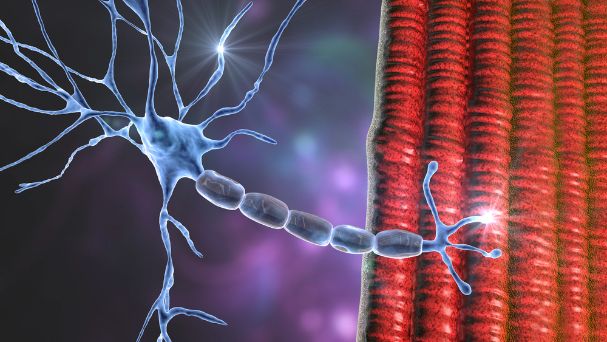Motor neuron disease (MND) is a group of diseases that damage motor neurons, the nerve cells in the brain and spinal cord that control muscles. These are the muscles that move your arms, legs and other parts of your body.
The brain sends electrical signals to the nerve cells, which then synapse in the spinal cord and send out along motor neurons in peripheral nerves, to tell the muscles to contract. Before you can move a muscle, the upper motor neuron nerve cells in your brain send the signal through the spinal cord to the lower motor neuron neurons in your limbs and other muscles.
Your muscles use the information from your motor neuron nerve cells to do things like chewing, speaking, moving your arm and leg, breathing and swallowing. If your motor neurons are damaged, you may not be able to do any of these tasks.
Symptoms vary depending on the type of MND you have and which muscles are affected. Some people experience symptoms such as weakness, numbness, clumsiness and spasticity of their muscles. Others have twitching or shaking (fasciculations) of their muscles that disrupt their sleep.
Early onset: Most people with MND experience symptoms that begin in their hands, feet or limbs and spread to other areas of the body as the condition worsens. Usually these aren’t painful and don’t affect your senses.
Limb onset: Your limbs are weaker, with problems doing things like buttoning your shirt or writing. You might also have trouble walking or frequently trip and fall.

Bulbar onset: You have difficulty using your mouth and throat to swallow or speak, or you might cough up often. These symptoms can also be accompanied by other problems, such as poor balance and confusion.
Respiratory failure: In some cases, people with MND can’t breathe on their own, and they die from respiratory failure. This happens when the lungs cannot take in oxygen or expel carbon dioxide, which is what your blood needs to survive.
ALS: This is the most common type of MND, with a rapid onset and widespread muscle wasting. ALS causes weakness in the arms, legs and hands, and makes it difficult to talk, swallow or breathe. It is fatal if you don’t get treatment, so it is important to see a doctor as soon as possible if you notice any of these symptoms.
Spinal muscular atrophy: This is an inherited condition that is more common in children than adults, and it begins when the SMN1 gene is defective. The defective gene means there isn’t enough SMN protein produced, so the lower motor neurons in your spinal cord can’t work properly. This causes a slow but progressive muscle wasting in your arms, legs and mouth.
PMA: This is a rare form of MND that progresses more slowly than ALS, but people with this type have some of the same symptoms as those with ALS, such as muscle weakness and fasciculations. The main difference is that people with PMA don’t have the twitching or shaking of their muscles.








